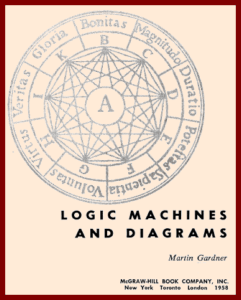A logic machine is a device, electrical or mechanical, designed specifically for solving problems in formal logic. A logic
diagram is a geometrical method for doing the same thing. The two fields are closely intertwined, and this book is the first attempt in any language to trace their curious, fascinating histories.
Let no reader imagine that logic machines are merely the play-things of engineers who happen to have a recreational interest in symbolic logic. As we move with terrifying speed into an age of automation, the engineers and mathematicians who design our automata constantly encounter problems that are less mathematical in form than logical. It has been discovered, for example, that symbolic logic can be applied fruitfully to the design and simplification of switching circuits. It has been found that electronic calculators often require elaborate logic units to tell them what steps to follow in tackling certain problems. And in the new field of operations research, annoying situations are constantly arising for which techniques of symbolic logic are surprisingly appropriate.
The last chapter of this book suggests some of the ways in which logic machines may play essential roles in coping with the stagger ing complexities of an automated technology.
Although the book consists for the most part of material drawn from widely separated and often relatively inaccessible books and journals, it also contains much that has not previously been published; at least, not in a layman's language. The reader will find, for example, some unfamiliar uses for the well known Venn circles;
an explanation of a novel network diagram for solving problems in the propositional calculus; a popular exposition of the new binary method of handling the calculus; and instructions for making quaint cardboard devices that identify valid syllogisms and show the formal fallacies of invalid ones.
The reader may wonder why so much of the first chapter is devoted to the life and personality of Ramon Lull. The answer is that Ramon's life is much more fascinating than his eccentric logic.
Other logicians mentioned in the book may have been far from dull to those who knew them, but with the possible exception of Lord Stanhope, recorded details of their lives are comparatively drab and colorless. Lull's Quixotic career is little known outside of Spain and France, and I make no apologies for introducing the reader to one of the most remarkable tragicomic figures of the Middle Ages.
In choosing symbols for the sentence connectives of the propositional calculus I have adopted those employed by Professor Alonzo hurch in Volume I of his Introduction to Mathematical Logic, 1956. The symbol for negation, ~, I have used throughout, even though the logic under consideration may be the traditional class logic or its modern formalization as Boolean algebra or the algebra of sets. In class logic it is customary to speak of a "complement"
rather than a "negation" and to symbolize it as à or A', but in this book so little notation is used for the class logic that it seemed best to avoid introducing special symbols for it.
In Collection
#864
Read It:
Yes
#864
Read It:
Yes
|
|
||||||||||||||||||
